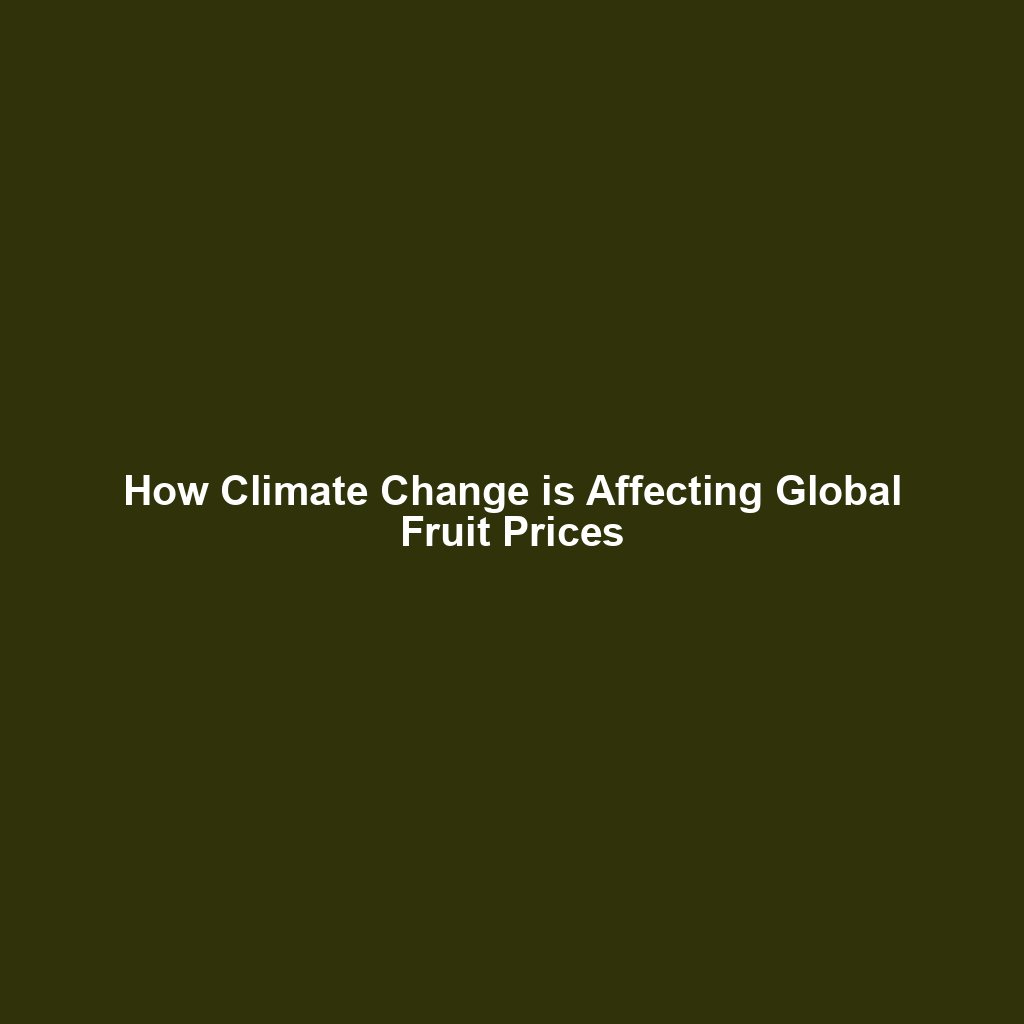
Introduction
How Climate Change is Affecting Global Fruit Prices is a topic of growing concern among economists, farmers, and consumers alike. The agricultural sector is highly sensitive to climatic conditions, and any significant changes in weather patterns can have profound effects on crop yields, quality, and ultimately, market prices. This article delves into the intricate relationship between climate change and fruit prices, exploring the various factors at play and the potential long-term implications for global food security and economic stability.
Chapter 1: The Impact of Climate Change on Agriculture
1.1 Changing Weather Patterns
Climate change has led to more erratic weather patterns, including increased frequency and intensity of extreme weather events such as droughts, floods, and storms. These changes can severely disrupt agricultural activities, particularly fruit farming, which is highly dependent on stable climatic conditions. For instance, prolonged droughts can lead to water scarcity, affecting irrigation and reducing crop yields. On the other hand, excessive rainfall can cause flooding, leading to soil erosion and crop damage.
1.2 Temperature Fluctuations
Temperature is a critical factor in fruit cultivation, influencing everything from flowering and pollination to fruit development and ripening. Climate change has resulted in rising average temperatures and more frequent heatwaves, which can stress plants and reduce their productivity. For example, many fruit trees require a certain number of chill hours (periods of cold weather) to break dormancy and produce fruit. Warmer winters can disrupt this process, leading to lower yields and poorer fruit quality.
1.3 Pests and Diseases
Warmer temperatures and changing precipitation patterns can also create favorable conditions for the proliferation of pests and diseases. Insects such as fruit flies and aphids thrive in warmer climates, posing a significant threat to fruit crops. Additionally, fungal and bacterial diseases can spread more rapidly in humid conditions, further exacerbating the challenges faced by fruit farmers. The increased use of pesticides and fungicides to combat these threats can lead to higher production costs and potential environmental and health concerns.
1.4 Soil Health and Fertility
Soil health is another critical factor in fruit production, and climate change can have a significant impact on soil quality and fertility. Changes in temperature and precipitation can alter soil moisture levels, affecting nutrient availability and microbial activity. Extreme weather events such as heavy rainfall and flooding can lead to soil erosion and nutrient loss, while prolonged droughts can cause soil compaction and reduced fertility. Maintaining healthy soils is essential for sustainable fruit production, and climate change poses a significant challenge in this regard.
Chapter 2: Agricultural Price Analysis
2.1 Supply and Demand Dynamics
The prices of agricultural products, including fruits, are primarily determined by the forces of supply and demand. Climate change can disrupt these dynamics by affecting both the supply side (production) and the demand side (consumption). Reduced crop yields due to adverse weather conditions can lead to supply shortages, driving up prices. Conversely, favorable weather conditions can result in bumper harvests, leading to oversupply and lower prices. On the demand side, changes in consumer preferences and purchasing power can also influence fruit prices.
2.2 Market Volatility
Climate change can contribute to increased market volatility, making it more challenging for farmers and traders to predict and respond to price fluctuations. Extreme weather events can cause sudden and unexpected disruptions in supply chains, leading to sharp price spikes or drops. For example, a severe frost in a major fruit-producing region can wipe out a significant portion of the crop, leading to a sudden surge in prices. Similarly, a bumper harvest in another region can lead to a glut in the market, causing prices to plummet.
2.3 Cost of Production
Climate change can also affect the cost of production for fruit farmers, influencing market prices. Increased frequency of extreme weather events can lead to higher costs for irrigation, pest control, and other inputs. Additionally, the need for more resilient crop varieties and advanced farming techniques can drive up production costs. These increased costs are often passed on to consumers in the form of higher prices. Furthermore, the economic impact of climate change on other sectors, such as transportation and energy, can also affect the overall cost of fruit production and distribution.
2.4 Global Trade and Market Integration
Global trade and market integration play a significant role in determining fruit prices. Climate change can disrupt international trade by affecting the production and export capacity of major fruit-producing countries. For example, a drought in a key exporting country can lead to reduced supply in the global market, driving up prices. Conversely, favorable weather conditions in another country can lead to increased exports and lower prices. Additionally, trade policies, tariffs, and exchange rates can also influence fruit prices in the global market.
2.5 Long-term Implications
The long-term implications of climate change on fruit prices are complex and multifaceted. On one hand, increased frequency of extreme weather events and changing climatic conditions can lead to greater uncertainty and volatility in the market. On the other hand, advancements in agricultural technology and practices can help mitigate some of the negative impacts of climate change, leading to more stable and sustainable fruit production. However, achieving this balance will require significant investment in research, infrastructure, and policy support.
Conclusion
In conclusion, climate change is having a profound impact on global fruit prices, affecting everything from crop yields and quality to market dynamics and production costs. The agricultural sector must adapt to these changing conditions through innovative practices, resilient crop varieties, and sustainable farming techniques. Policymakers, researchers, and industry stakeholders must work together to address the challenges posed by climate change and ensure a stable and secure food supply for future generations. By understanding the intricate relationship between climate change and fruit prices, we can better prepare for the uncertainties ahead and build a more resilient agricultural system.



